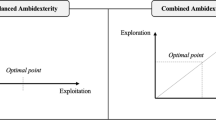Abstract
Drawing on a social network approach this paper proposes a methodology that helps with the empowerment and development of interorganisational networks in clusters. Paper emphasises the necessity of establishing relationships with other firms and external agents in order to empower the creation and diffusion of knowledge, through factors such as innovation. The aim of the proposed methodology is to know how required knowledge should be located and diffused to identify the opportunities motivating the creation of particular interorganisational networks. Similarly, it is also important to know how to determine which agents might to take advantage of these opportunities creating networks.








Similar content being viewed by others
References
Boix, R., & Galletto, V. (2006). Sistemas locales de trabajo y distritos industriales marshallianos en España. Revista de Economía Industrial, 359, 165–184.
Cabrera, A., & Cabrera, E. (2002). Knowledge-sharing dilemmas. Organization Studies, 23(5), 687–710.
Cohen, W. S., & Levinthal, D. A. (1990). Absorptive capacity: A new perspective on learning and innovation. Administrative Science Quarterly, 35, 128–152.
Cooke, P. (2002). Knowledge economies. Clusters, learning cooperative advantage. London: Routledge.
Dosi, G. (1988). Sources, procedures and microeconomic effects of innovation. Journal of Economic Literature, 26, 1120–1171.
Dyer J. H., & Singh, H. (1998). The relational view: Cooperative strategy sources of interorganisational competitive advantage. Academy of Management Review, 23, 660–679.
Grabher, G. (1993). The weakness of strong ties: The lock-in of regional development in the Ruhr area. In G. Grabher (Ed.), The embedded Firm: On the socioeconomics of industrial networks (pp. 255–277). London: Routledge.
Hitt, M. A., Hoskisson, R. E., Johnson, R. A., & Moesel, D. D. (1996). The market for corporate control firm innovation. Academy of Management Journal, 36, 1084–1119.
Kanter, R. M. (1988). When a thousand flowers bloom: Structural, collective, social conditions for innovation in organizations. In B. M. Straw, & L. L. Cummings (Eds.), Research in organizational behavior (pp. 169–211). Greenwich, CT: JAI Press.
Kogut, B., & Zander, U. (1992). Knowledge of the firm, combinative capabilities, the replication of technology. Organization Science, 3, 383–397.
Lane, P. J., & Lubatkin, M. (1998). Relative absorptive capacity interorganisational learning. Strategic Management Journal, 19, 461–477.
Masiá, E., Albors, J., Golf, E., & Capó, J. (2004). Identifying key technology success factors in an industry by the application of an analysis model—STRELNET—to the links of the productive value chain among the main economic agents of a microcluster. Paper IAMOT 2004. Washington D.C.
McEvily, B., & Zaheer, A. (1999). Bridging ties: A source of firm heterogeneity in competitive capabilities. Strategic Management Journal, 20, 1133–1156.
Moran, K., & Ghoshal, S. (1996). Value Creation by Firms. Academy of Management Best Paper Proceedings, 41–45.
OES (2003). Competente Development in SMEs. Observatory of European SMEs 2003, no. 1.
Porter, M. E. (1980). Competitive strategy: Techniques for analysing industries and competitors. New York: Free Press.
Porter, M. E. (1990). The competitive advantage of nations. Harvard Business Review, March–April 1990
Putnam, R. (2000). Bowling alone: the collapse and revival of American community. New York: Simon and Shuster.
Van Waarden, F. (2001) Institutions innovation: The legal environment of innovating firms. Organization Studies, 22(5), 765–795.
Author information
Authors and Affiliations
Corresponding author
Rights and permissions
About this article
Cite this article
Capó-Vicedo, J., Expósito-Langa, M. & Molina-Morales, F.X. Improving SME competitiveness reinforcing interorganisational networks in industrial clusters. Int Entrep Manag J 4, 147–169 (2008). https://doi.org/10.1007/s11365-007-0059-7
Published:
Issue Date:
DOI: https://doi.org/10.1007/s11365-007-0059-7




